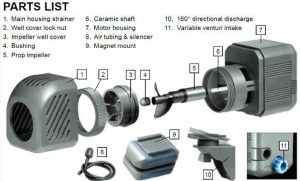
View On Amazon
| Size | Dimensions | Tank Size | Noise Level | Longevity | Price |
| 530 GPH | 3.2″ x 1.9″ x 2.3″ | 25-55 Gallons | Low | 2-6 Years | Medium |
The Seio P530 Prop Pump is a middle ground powerhead, placed between maxi-jets and Tunze in terms of quality. It provides excellent flow and distributes it over a great area. This makes the current very gentle, supporting slow swimmers and slow current corals.
While Rio does distribute this powerhead, it does not suffer the constant failures that Rio pumps are known for. This is because Rio does not actually make the pump, they just distribute them.
Set-up

Setting this pump up has been one of the easiest so far. Simply slide off the front cover of the powerhead, then slide the magnetic mounting bracket into place. Then slide the front cover back into place and you’re ready to mount the powerhead.
As with all magnetic powerheads you will want to slowly bring the magnets together, with the aquarium glass between them. For the easiest time put the two magnets against the glass but in different areas. After that you can slide them together so that there is no chance of impact against the glass. The magnets work on glass up to 3/8″ thick.
When starting the powerhead you will hear a fair bit of rattling followed by a quiet hum. The Seio is a rather quiet pump over all, but this rattling fixes any and all reverse runnings. That being said the Seio P530 is not made to be turned on frequently and should never be used as a wave maker. This will drastically shorten the lifespan of the impeller, not to mention be much nosier than anyone would want.
The Seio P530 is well covered, ensuring even the slowest of swimmers do not get pulled into the powerhead. This is one of the benefits a square shape has on the powerhead. While the Seio P530 is small it’s a bit more difficult to hide in the tank.
As a final note the cord is a generous 6 feet long, allowing fairly free placement of this powerhead. The main restriction on depth is actually the venturi air injector. The provided tubing is rather short, and will only work when the powerhead is just a few inches underwater.
extra issues
impeller can be unreliable. If the powerhead stops working check this first.
Assembly

The Seio certainly takes awhile longer to take apart and deep clean than most powerheads, but it is none too difficult. First you will want to unplug and remove the powerhead from the aquarium. You can either remove the magnetic mount with it or partially disassemble the powerhead underwater, which is how I choose to do it.
With the Seio out of the water you will need to remove the front cover and unscrew the well cover lock nut. After that you need to remove the impeller well cover, prop impeller and ceramic shaft.
The impeller and shaft should be cleaned using a 50/50 mixture of water and vinegar. You can just leave these soaking for 15 minutes or so. wipe it down with a soft material that has not been used with chemicals to remove any remaining debris.
You can use the 15 minutes of soak time to either scrub the grate clean or pick out any large debris. I like to leave the coralline algae on my powerhead, but it can make the front grate harder to detach next time.
Reassemble the powerhead in the reverse order and resubmerge it in the tank. Rotate it to let out any air before turning it back on.
Flow & Adjustments
The flow speed is not adjustable, and the output is already very well distributed. I highly advise against diffusing the water unless you are keeping very slow swimming fish in your aquarium.
The direction of the powerhead is limited to only 160 degrees, but the magnets can be turned to give you a full 360 degrees. If you are turning the magnets be sure to turn both at the same time.
Warranty & Lifetime
The Seio P530 comes with a decent 6 month warranty, which will cover the majority of failures and faulty parts. The main culprit of these failures is the impeller, which can either come loose or simply break. Even after warranty it is much easier to custom order the part instead of replacing the entire powerhead.
As mentioned right at the beginning this pump is not made by Rio and will last much longer than Rio pumps. Provided the impeller does not break ahead of time, you can expect a range between 2-6 years from the average Seio P530. Over all it’s a good lifetime for the price.